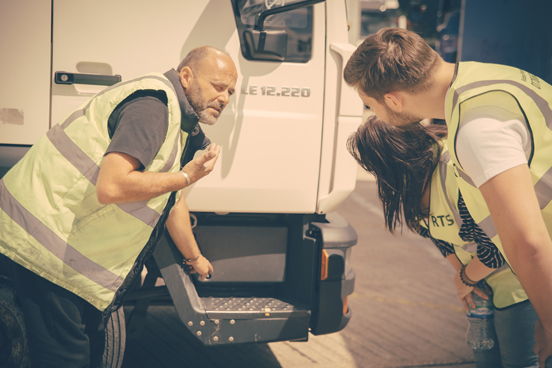- UP TO £400 OFF*
- OFFER VALID UNTIL 31st July 2024
HGV licence holders rely on their driving skill to keep themselves and other road users safe, but there is also another highly important factor involved which needs to be constantly monitored. This factor is the roadworthiness of your vehicle, as not only does failing to properly maintain it put lives at risk, but you also increase the likelihood of a roadside prohibition.
HGV vehicles are highly complex machines, with countless systems and moving parts that all need to work well together at peak efficiency. From air brakes to tachographs, there are numerous parts of a vehicle that those hoping to hold on to their HGV licence need to keep in good working order.
In the same way, as a car must pass a yearly MOT test to remain road legal, HGV vehicles must pass a yearly HGV safety inspection by VOSA (The Vehicle and Operator Services Agency) or by a VOSA accredited testing facility. Any HGV licence holder who’s been through one will tell you that it’s a really thorough test and for a good reason.
Unlike daily walkaround checks carried out by those with a HGV every day, an annual HGV safety inspection is a comprehensive one that will usually require a second person (usually the driver) to help the testing agent. The test requires the vehicle to pass a series of minimum standards that assess the vehicle’s roadworthiness.

Usually conducted on a suitable hardstanding, the first part of the test involves look at a variety of factors, such as:
Every visible part of the vehicle is checked, with the tester moving methodically over the entire structure, including inside the driver’s cab. It’s important to say at this point that HGV licence holders should be routinely checking many of the elements included in an annual safety inspection to ensure roadworthiness at all times.
There are just as many components underneath the vehicle that need to be assessed over a pit, such as:
The expert eye of the VOSA accredited inspector will be looking for signs of wear and tear, loose bolts and all manner of warning signs. It may seem to some that it’s too rigorous, but every part of the test is carried out with the safety of everyone on the road in mind and is entirely necessary.
If you want to learn more about annual HGV safety inspections, you can get everything you need to know in intricate detail by reading The VOSA Guide to Maintaining Roadworthiness on the government website. This pdf document will give you everything you need to know to perform your own checks and understand what to expect when inspection time comes around.
However, if you are considering training for your HGV licence, you can find out all about the different types that are available for each type of vehicle and what’s involved in obtaining them by filling in the enquiry form or call us on 08000315765
Just fill in your details below and we’ll send you a free theory test practice with.
Just let us know your score...
We reserve the right to contact you in the
future via this email
By Signing up, you agree to our Terms & Privacy Policy
By Signing up, you agree to our Terms & Privacy Policy
By Signing up, you agree to our Terms & Privacy Policy
By Signing up, you agree to our Terms & Privacy Policy
By Signing up, you agree to our Terms & Privacy Policy